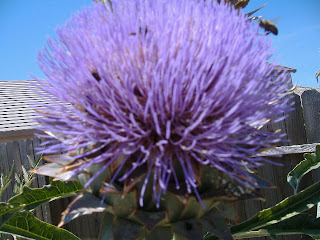 When life gives you lemons.....
When life gives you lemons.....This is the sad state of Bill & Venus' Artichoke Garden I'm sad to say. The patch of dirt that had been yielding delicious offerings of nightly artichokes looks dried out and sad at the moment. This is the way it always looks at the end of the season I must admit. It's just that -- thanks to some unseasonably hot weather in April and May -- artichoke season came to a close a tad early this year.
It's also painfully clear, judging from the purple artichoke flowers, that we should have given away far more than we did. Although one of the plants is an ornamental, there are probably another 20 artichokes that could have been steamed and then consumed by a lucky neighbor/friend.
 Alas, a missed opportunity. These chokes are nothing more than a good flower show now.
Alas, a missed opportunity. These chokes are nothing more than a good flower show now.But wait!
One man's trash is another man's treasure!
It has been the source of mock disgust, of course, to watch the bees I acquired to pollinate MY garden, fly over the fence to pollinate the NEIGHBOR'S garden. Bees, of course, have no respect for property lines. The hive may be in my yard, and I may feed them generous helpings of sugar water, but bees are bees. If they find a source of pollen somewhere else -- that's where bees go.
So, for the past month, I've been watching my bees take flight out of the hive, only to fly over the fence. I have witnessed this day after day after day, even though my yard is populated with plenty of flowers and pollen. Apparently, there's better stuff to be had somewhere else.
 But, when I noticed the artichokes start to flower, I also noticed they were thick with a white pollen. Each purple stem was coated with enough pollen to sustain five colonies of bees, and sure enough, it appears to be to my hive's liking.
But, when I noticed the artichokes start to flower, I also noticed they were thick with a white pollen. Each purple stem was coated with enough pollen to sustain five colonies of bees, and sure enough, it appears to be to my hive's liking.And not just my hive either. Each artichoke flower is covered with bees, hornets and even a massive leaf-cutter bee that appears big enough to eat one or all four of my cats. I know leaf cutter bees are large -- but battleship large?
Oh well, beggars can't be choosers I suppose.
 The photos from my ultra-cheap digital camera don't do a whole lot of justice -- I know. But trust me when I tell you that each artichoke flower is covered with a multitude of bees. Not only that -- I can also see the line of flight between the hive in my yard and the bees that are making a beeline for the for the artichoke bed.
The photos from my ultra-cheap digital camera don't do a whole lot of justice -- I know. But trust me when I tell you that each artichoke flower is covered with a multitude of bees. Not only that -- I can also see the line of flight between the hive in my yard and the bees that are making a beeline for the for the artichoke bed.I hesitate to call them "my bees" because bees belong to themselves. They're just hanging out in the yard.
But -- for now? I have a sense of pride and accomplishment. The artichoke bed that gave us more artichokes than we could possibly handle earlier this spring, is now supporting a wide variety of nature's creatures.
I wouldn't have it any other way.

2 comments:
I have never seen an artichoke blossom -- so pretty! Can you tell me a little about growing these? When do you plant/harvest them? Are they perennial? Did you plant these as seed or transplant nursery starts? I saw a cute little artichoke at Home Depot yesterday that I was tempted to take home, but I suspected it wasn't the right season.
Christine,
Artichoke season is now done for this year (obviously), but the time to plant for next year is now or later this fall.
Artichokes plants grow through the winter months, really start to take off in February and March, and then produce artichokes in April, May and June.
The plant then completely dies back in the summer. It's just too hot for them. But, when summer breaks, new shoots emerge from the roots. And those shoots develop into large plants, which will give you artichokes next spring!
BEWARE: Artichokes will take over raised beds. Set aside an area for them and give them that area. They will spread out and take over.
Post a Comment